The Best Weightlifting Shoe Guide on the Web. All You Need to Know…
I’ve written this weightlifting shoe guide as a complete answer to the various questions I’ve been about them. In fact, I think I’ve been asked more questions about weightlifting shoes than any other aspect of training kit.
In this weightlifting shoe guide I cover absolutely everything you need to know about them… weightlifting shoe anatomy, why you need to wear them, how they differ from normal trainers, where to buy them, do they work etc etc.
By the end of the weightlifting shoe guide you’ll know everything worth knowing about weightlifting shoes!
What are weightlifting shoes?
Like most other sports, weightlifting has specific equipment and clothing to be worn when training and competing. The particular difference is in the footwear – weightlifting shoes are specifically designed to help a weightlifter to lift more weight thanks to a series of design features.
Weightlifting shoes have a raised heel, a stiff midsole, tough, supportive uppers, strong laces, velcro straps for additional security, a completely flat sole and in some cases are heeled with materials such as wood.
View this post on Instagram
All of these features combined contribute to allowing the lifter to lift much more weight than they would do in normal trainers. They also help to reduce the injury risk by improving biomechanics of the lifter.
How is a weightlifting shoe different to normal trainers?
Weightlifting shoes have a series of differences between themselves and normal trainers, from the materials used to the construction of the shoe, they are totally different from normal trainers.
The whole make up of the trainer is designed to improve efficiency in a lift – from the flat sole on the bottom, the angled shape of the midsole, the material of the midsole, the velcro strapping to secure the laces and fit, the stronger leather in the upper to cope with the movement of the feet in weightlifting.
I’ll cover the differences in the next section, where we’ll break down the anatomy of a weightlifting shoe in more detail. What will become clear is that although they make look like relatively standard trainers, there are a lot of design differences that contribute to making them a much more efficient shoe for weightlifting.
Anatomy of a weightlifting shoe
Weightlifting shoes are constructed from a different pattern than normal training shoes and the materials used aren’t quite the same. I’ve had an infographic done to show how the design differs…
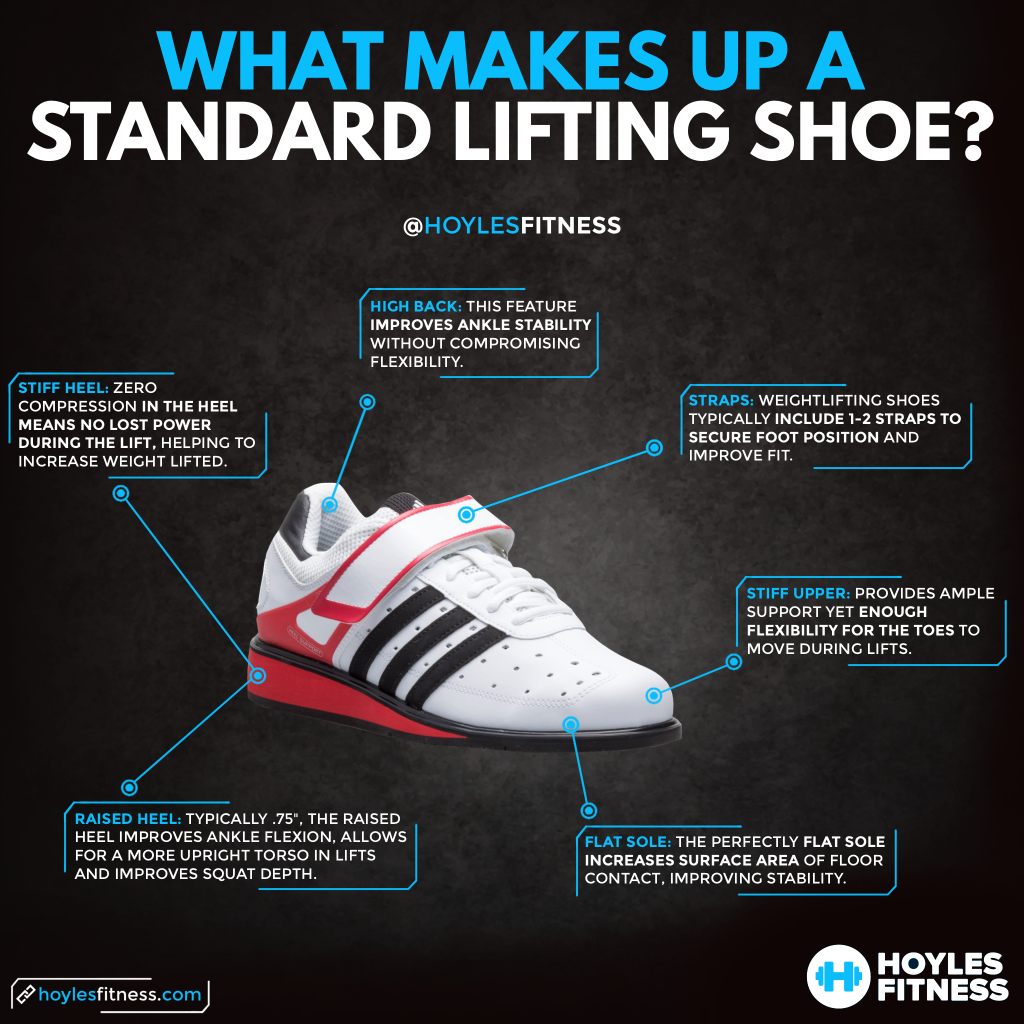
These elements are the differences between weightlifting shoes and normal trainers. Each one is the result of a few decades of innovation, not to mention millions of training hours logged and constant athlete feedback.
The basic design has remained the same throughout the decades and is likely to. The innovation is probably going to come from wearable tech and materials rather than design in the long term.
Do weightlifting shoes work?
Absolutely. There is a lot of pointless equipment in many sports, but one absolutely fundamental item of kit for weightlifting is a pair of weightlifting shoes.
There is almost no way you can even contemplate lifting seriously without weightlifting shoes. From the lack of support from the midsole to the reduced stability from the soft upper, there are too many design flaws from a lifting standpoint in normal trainers.
Looking at weightlifting from a technical aspect, the change of the torso angle brought about by weightlifting shoes give an technical advantage that you could only recreate with quite insane levels of mobility or biomechanics!
This isn’t opinion either, it’s fact. Here is a study that shows marked improvements in ankle mobility, knee flexion and torso angle (all vital to weightlifting) during squat mechanics thanks to weightlifting shoes.
In a more simplistic and visual representation from the prehab guys, here’s what wearing weightlifting shoes does to your body…
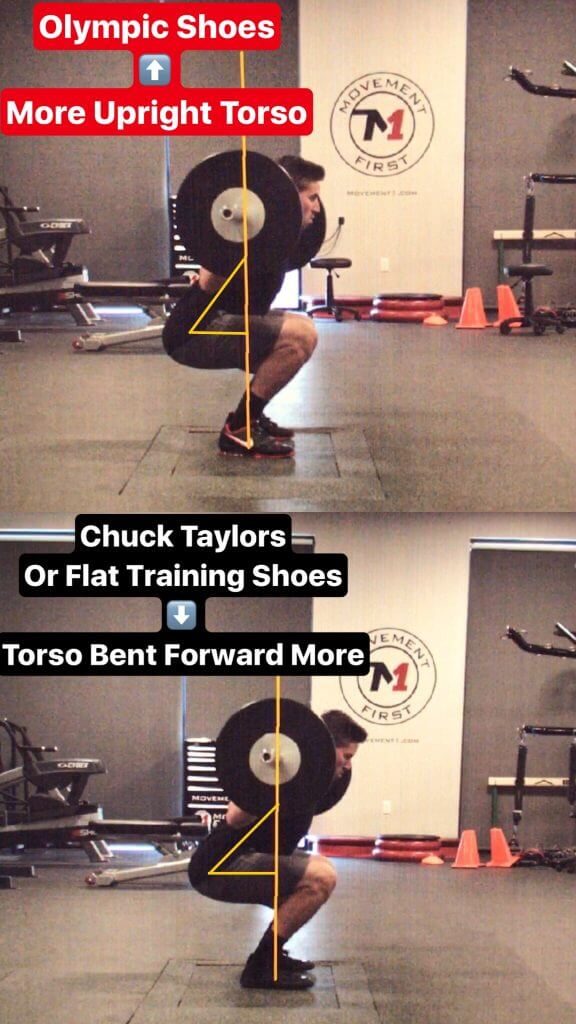
What about CrossFit Nano’s as a weightlifting shoe?
If you’re a CrossFit fan you may be aware of shoes by Reebok called Nano’s – these are shoes worn by CrossFitters that are designed to be multi-functional. They are a combination of a supportive upper and a stiffer-than-normal, flat rubber sole.
The thinking is that they combine a lot of the supportive elements of weightlifting shoes with the flexible, free-er moving sole of standard training shoes.
Whilst they are great for CrossFit where there are multiple and very varied demands on the athlete, they aren’t ideal as pure weightlifting shoes because they only offer some of the benefits to the lifter – they don’t have the right midsole angle, they are a little too soft in the upper and the sole isn’t quite stiff enough.
They are a good all-round training shoe, but they aren’t a perfect weightlifting shoe. If you are a CrossFitter, they’re fantastic. If you’re a weightlifter, you could pick a better pair of training shoes.
These are the Nano’s…
As I said, the Reebok Nano’s are a great all-rounder and are far more suitable for weightlifting than ‘normal’ trainers, but they aren’t perfect. If you’re serious about weightlifting, you will have to graduate to real weightlifting shoes as soon as you can.
If your training is purely CrossFit or multi-functional work though, these will be perfect for your needs.
What different types of weightlifting shoes are there?
There are all kinds of shoes made by a wide variety of brands, but they share a lot of the commonalities of design. The differences largely are variations on a theme such as heel height, sole stiffness, number of straps, one or two materials used in the construction.
The weightlifting shoes you select will largely be down to factors such as…
- Personal style preference
- Brand loyalty
- Limb length/body proportions
- Foot size and shape
- Ankle flexibility
- Material preferences
The standard heel height in a weightlifting shoe is .75 inches, but this varies up and down slightly and the choice you’ll make is determined by a number of factors. This guide below taken from the Athlete Audit sums up the decisions you’ll make around the shoes perfectly…
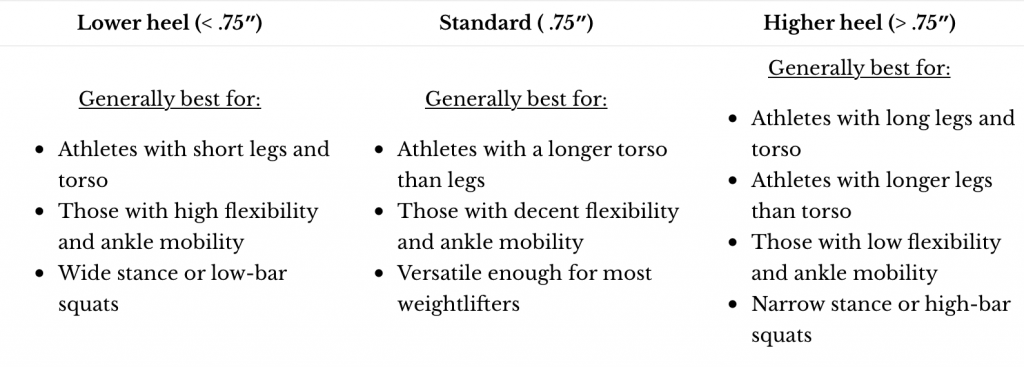
What lifting should I wear them for?
Just like when I see people wearing a lifting belt for every workout, I cringe when I see people wearing weightlifting shoes for non-weightlifting workouts. There’s a time and a place for wearing weightlifting shoes…. when you’re doing weightlifting!
Weight training is different. You don’t need the benefits afforded to you by a raised heel or stiff midsole for workouts that don’t involve weightlifting or squat movement patters. In fact, they can actually put you off balance in lots of ways. They’re not a great choice for deadlifting in for example, because they force your centre of mass forward and affect your balance.
If your workout consists of exercises such as pull ups, bench press, curls, leg extensions etc, YOU DON’T NEED TO WEAR WEIGHTLIFTING SHOES!
Save them for when you need them.
Can you wear them too much?
Actually, you can.
Just like a woman who wears high-heeled shoes all day, wearing weightlifting shoes for too long a period of time can have an effect on calf muscles, as I found out myself. I would wear them for my weightlifting workouts, but just leave them on as I did my accessory work. It meant I was spending upwards of 10 hours per week in my weightlifting shoes, which wasn’t good for my calf flexibility.
Why?
They raise your heel slightly so shorten the gastrocnemius and soleus muscles over time. If you wear the shoes for many hours per week, over a long period of time you can have an effect on the muscles, resulting in a tightness and increasing possible injury risk. I found this out to my peril and suffered a calf strain as a result of wearing my weightlifting shoes too much.
To avoid this, only wear them for weightlifting and squatting – any other lifting, wear other shoes for to prevent any unnecessary calf muscle issues. Also, do extra calf muscle stretches to offset any shortening issues you’ll have from the raised heel.
Can I run in weightliftng shoes?
No. If you could design a training shoe less suitable for running in, I’d like to see it.
The soles in weightlifting shoes are flat and stiff. The midsole is hard and provides no cushioning at all. The raised hell shifts the centre of mass forward, making running balance more difficult to attain.
The uppers are made from a stiff leather, making them heavier and less flexible than running shoes. The velcro strapping allows much less movement than normal trainers and the ventilation is a fraction of what you’d expect in normal running trainers, so they’d be likely to give you pretty sweaty feet if you wore them for a lot of hard miles.
Running in weightlifting shoes would be like swimming in ice skates. A lot more difficult than it should be.
Where can I buy weightlifting shoes?
They’re a bit of a niche product, so you’re unlikely to find them in a general sports shop. The best place is generally online, where you’ll pick up shoes at the cheapest price, read reviews left by other lifters and also compare different products side-by-side.
As with most other things, Amazon is probably your best bet – they’re usually the best price and have the best reviews, giving you an honest user score. I personally wear the Adidas Power Perfect 2’s, which suit my requirements and offer (in my opinion) a great blend of performance and price.
Here’s a few of the more popular shoes you’ll see in weightlifting gyms around the country….
What Should I spend on a weightlifting shoe?
Like everything, the price varies. You can pick up a solid pair of weightlifting shoes for as little as £50, but then if you want to spend the extra money you can go to over £200.
Price doesn’t always determine quality and thanks to your biomechanics and lifting style (as covered further up the article), you may find that the best shoes for you and your lifting are towards the cheaper end of the market – in which case, lucky you!
Personally I think most lifters will get away with spending £50-£100, but be willing to be flexible for the right pair. You’d rather spend the extra on a greta pair of shoes than penny-pinch and end up with a pair of weightlifting shoes that just aren’t right.
What to be aware of with weightlifting shoes
With weightlifting shoes being specialist kit with a particular purpose in mind, the market hasn’t been flooded with poor quality versions, so the general quality is very high. I personally have had my latest pair of Adidas Power Perfect 2’s for nearly 4 years, I’ve used them an average of 4 days per week in that time and they are still going strong!
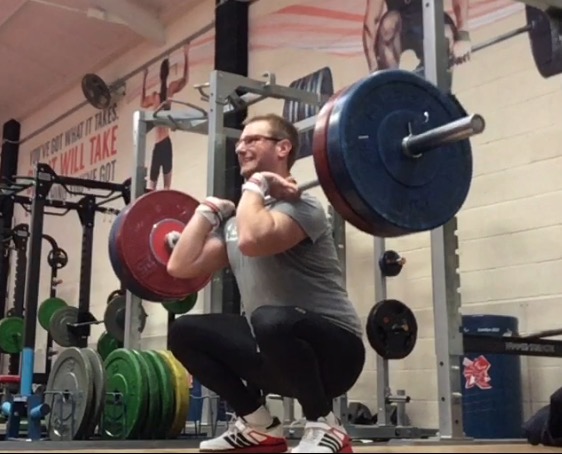
Quality isn’t a problem, but how you use them may cause an issue or two. Here’s my thinking of what you need to be aware of with weightlifting shoes…
- They artificially improve mobility, so you forget to stretch. Make sure you stretch – it’ll reduce your injury risk.
- Don’t use them for everything – they aren’t ideal for deadlifting and you don’t need them for bodybuilding workouts.
- You can become over-reliant on them because they help your technique. It’s still worth barefoot squatting every now and then, just to keep your skills sharp.
If you keep these points in mind, you’ll certainly benefit as a lifter from wearing your weightlifting shoes. Take the time to read this weightlifting shoe guide, think about what you like, what you need and how much you are going to spend and make decisions accordingly.
If you are serious about weightlifting though, you’re going to need a good pair of shoes. Not only will they help you become a better lifter, they’ll also help you become a healthier all-round person because the improved lifting will translate into other areas of your fitness.
Feel free to share the weightlifting shoe guide with any of your lifting friends.
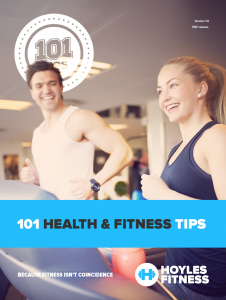
2 thoughts on “The Best Weightlifting Shoe Guide on the Web. All You Need to Know…”